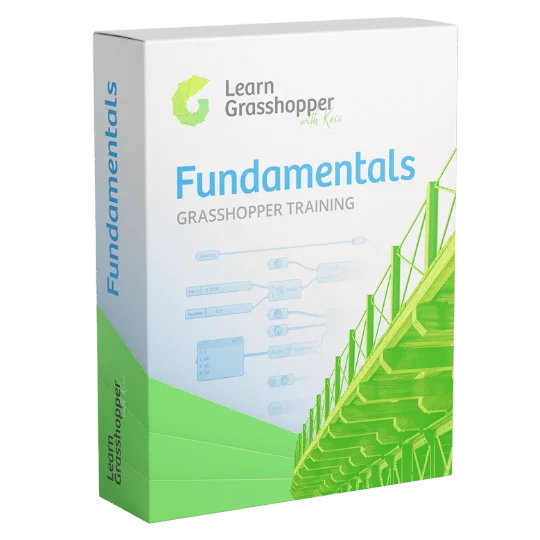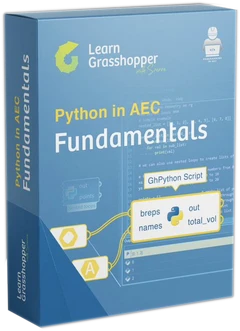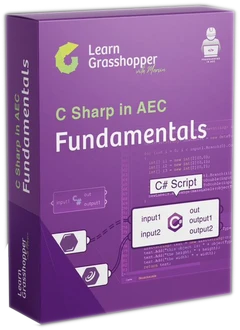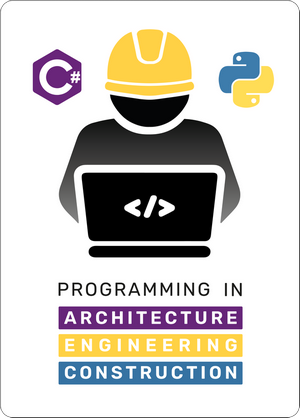Transform your engineering work into fun with Programming
Become a Computational Designer in 3 simple steps
-
Automate manual tasks in your projects -
Create your own tools and make work more enjoyable. -
Get ready for the AI revolution in engineering -
Learn coding basics to make AI tools work for you - Start a new, exciting career path as an Computational Designer get better job offers and stand out in the industry

Registration for the 2nd edition of Programming in AEC Fundamentals ends in:
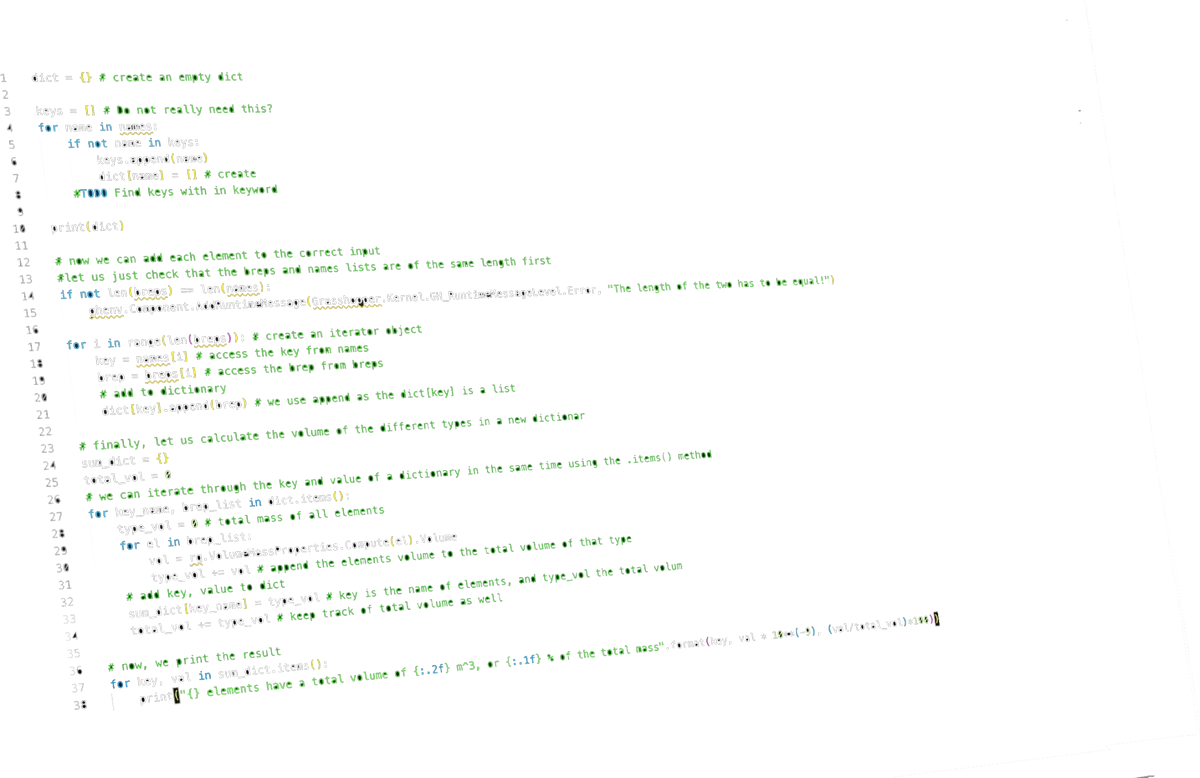
WHY PROGRAMMING IN AEC?
Because… the PROFESSION of a programmer is not for everyone. However, the SKILL OF PROGRAMMING AND COMPUTATIONAL DESIGNER ROLE – that’s a different story! And it has never been more in demand in the AEC industry.
We’re living in exciting times with lots of new tech tools becoming more user-friendly. Still, to really take advantage of these tools, you often need some basic coding skills. Even simple code generated by Artificial Intelligence needs to be understood to be used properly.
What IS PROGRAMMING IN AEC Fundamentals ?
You’ll be learning from top experts with years of experience in the AEC industry and teaching at leading technical universities. It doesn’t get better than this!
Thousands of students appreciate their approach, expertise, and delivery of up-to-date knowledge.

However, the SKILL OF PROGRAMMING is!
And it has never been more useful.
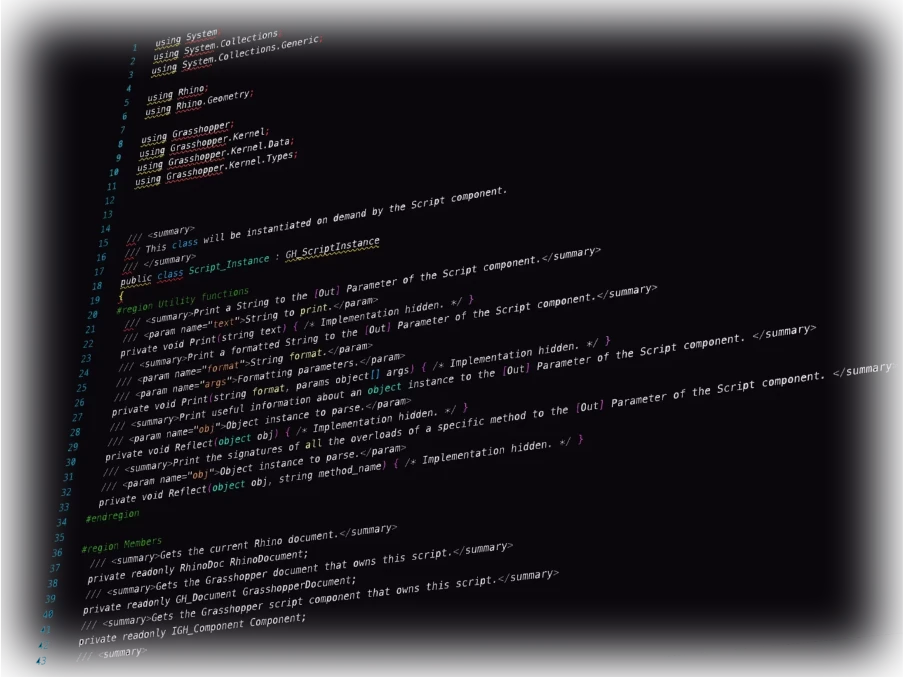
Programming in AEC Fundamentals Training
Highly practical online training in programming for AEC industry
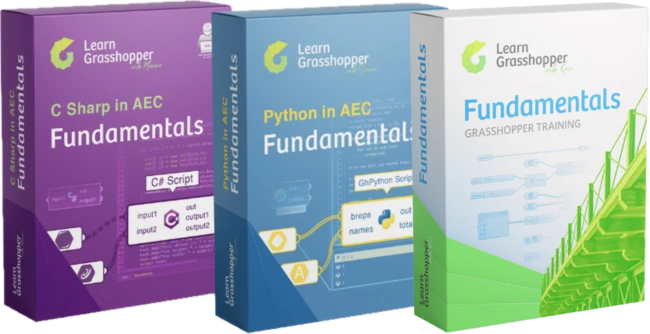
- Self-paced online training: Grasshopper Fundamentals + Python in AEC + C# in AEC from scratch (with lifetime access) which helps you reach intermediate programming level, at your own schedule
- Step-by-step approach: easily digestible bites of theory followed by presentation of practical examples and individual practical assignments
- Lifetime access to a closed Programming in AEC community – a space for questions, discussions, and mutual support on your learning path
- Three Live Q&A sessions with Trainers where you can ask your questions and get answers real-time
- +500 engineering examples of the application of Grasshopper, Python and C# with well-prepared practical assignments and homework
- 100% Satisfaction Guarantee – 30 days refund, no questions asked
Join architects and engineers
from more than 100 companies






















Is this training program for you?
- You realize that solving design challenges manually is not what a self-respecting modern engineer should do
- You want to see if the world of text programming in the AEC industry is for you
- You want to break free from the limits of visual programming – solve more complex problems, work on challenging projects, and have fun at the same time
- You want to get familiar with the tools used in the AEC industry and good, tested practices
- You’d like to start a new, exciting career path as an Computational Designer – grow as a professional, have more confidence in your abilities, get better job offers, and stand out in the industry
- You need contact with someone who will answer your questions and doubts so you don’t feel alone or stuck on your learning path
Why this training program?
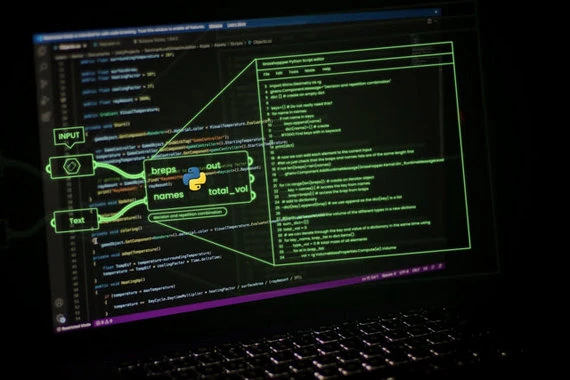
Years ago, we went throught the same journey you’re considering now.
Since then, we’ve been fortunate to serve as academic lecturers, teaching engineers the art of programming, while simultaneously working on world-class projects. Recognizing how programming has revolutionized our careers — transitioning from tools like Excel and AutoCAD to more advanced, future-oriented technologies — we are passionate about making engineering work both enjoyable and efficient.
Our training program stands out with its unique structure: a harmonious blend of 20% theory and 80% hands-on practice. The tasks are not just practical; they’re also engaging and gamified. Clues for one task might be cleverly hidden in another, offering challenges that are both stimulating and suited to your current skill level.
This training is the culmination of academic excellence combined with real-world experience in both architectural and engineering domains.
Is there any other way?
Well, there sure is...

Books
Provide extensive theoretical knowledge which, valuable as it is, does not translate into practical skills.

Internet tutorials
YouTube is full of programming tutorials, but but do you have the time to go through all the tutorials to find the right one that relates to your current challenges?

Trial and error method
Which is risky if you value your time and want to feel confident about your skills and have the knowledge properly structured in your head.
Or ...
Choose Programming in AEC Fundamentals Training Program that combines essential theory, hundreds of hands-on exercises, the total of 40-years' experience in design and teaching, and exciting examples from real-life projects!
A program created by Engineers for Engineers who want to revolutionize their way of working and...
...take the next step to becoming Engineer 4.0
What is in it for me?
// See what you gain from the Program

Learn practical application of visual and text-based programming

Automate manual design tasks to make your work more efficient

Connect to software API and take your software's capability to the next level

Start working on innovative projects and technologies on a daily basis

Take a step forward in your career and become a computational designer

Make your work feel less like work and more like something fun to do
Why are we so confident?

Associate Professor at NTNU
Senior structural engineer at Mulitconsult

Parametric Design Engineer
Founder of educational platform

PHD Candidate at NTNU
Senior Structural Engineer
- Education: One of the youngest professors in Computational Design globally.
- Technical Skills: Skilled Structural Engineer with a mix of practical know-how and theoretical insights. Proficient in C# for tool development and has created his own tools available on Food4Rhino.
- Work Role: Senior Structural Engineer at Multiconsult, focusing on design optimization and close collaboration with architects.
- Teaching Experience: Combines academic teachings with his keen interest in rapid FEM prototyping, BIM modelling, and generative design.
- Fun fact: Former Brazilian Jiu-Jitsu fighter, adding a layer of versatility to his persona.
- Education: Founder of LearnGrasshopper.com – educational platform aimed at enhancing the skills of Architects and Engineers, steering the AEC industry towards a digital and sustainable future. Creator of a successful course in Grasshopper fundamentals so far taken by 600+ engineers.
- Technical Skills: Renowned for mastering all Grasshopper tips and tricks. With years as a Parametric Design Expert, Krzysztof has contributed to significant projects in Scandinavia, notably the award-winning Randselva Bridge project where visual programming was extensively utilized.
- Ambition: Co-founded BIM Corner in 2019, which rapidly ascended as one of the top industry blogs globally. Passionate about how parametric design can uplift one’s career.
- Unique achievements: Honored as the best young engineer in Europe at the EFCA 2021 Future Leaders Competition.
- Education: Pursuing a Ph.D. at NTNU in design and computational studies.
- Technical Skills: Proficient in Python, C#, and Grasshopper, using them extensively in research and professional tasks.
- Work Role: Python instructor and Senior Structural Engineer at a large consulting office, focusing on automating tasks and improving solutions.
- Teaching Experience: Has guided students through design and programming courses, offering hands-on mentorship.
- Ambition: Eager to be part of projects that creatively combine design and technology.

Krzysztof Wojslaw
Parametric Design Engineer
Founder of educational platform
- Education: Founder of an educational platform aimed at enhancing the skills of Architects and Engineers, steering the AEC industry towards a digital and sustainable future.
- Technical Skills: Renowned for mastering all Grasshopper tips and tricks.. With years as a Parametric Design Expert, Krzysztof has contributed to significant projects in Scandinavia, notably the award-winning Randselva Bridge project where visual programming was extensively utilized.
- Ambition: Co-founded BIM Corner in 2019, which rapidly ascended as one of the top industry blogs globally. Passionate about how parametric design can uplift one’s career.
- Unique Aspect: Honored as the best young engineer in Europe at the EFCA 2021 Future Leaders Competition.

Marcin Luczkowski
Associate Professor at NTNU
Senior structural engineer at Mulitconsult
- Education: One of the youngest professors in Computational Design globally.
- Technical Skills: Skilled Structural Engineer with a mix of practical know-how and theoretical insights. Proficient in C# for tool development and has created his own tools available on Food4Rhino.
- Work Role: Senior Structural Engineer at Multiconsult, focusing on design optimization and close collaboration with architects.
- Teaching Experience: Combines academic teachings with his keen interest in rapid FEM prototyping, BIM modelling, and generative design.
- Unique Aspect: Former Brazilian Jiu-Jitsu fighter, adding a layer of versatility to his persona.

Sverre Magnus Haakonsen
PHD Candidate at NTNU
Senior Structural Engineer at COWI
- Education: Pursuing a Ph.D. at NTNU in design and computational studies.
- Technical Skills: Proficient in Python, C#, and Grasshopper, using them extensively in research and professional tasks.
- Work Role: Python instructor and Senior Structural Engineer at COWI, focusing on automating tasks and improving solutions.
- Teaching Experience: Has guided students through design and programming courses, offering hands-on mentorship.
- Ambition: Eager to be part of projects that creatively combine design and technology.
What do engineers say about
Programming in AEC Fundamentals training?
Guillermo Varela

Tech Support and Rhino Trainer at McNeel Europe
Sanjay Joshi

Computational Designer
Anna Lukasik

Track Designer | Parametric Designer at COWI
Didier Mwira

Civil Engineer
Jacek Wojciechowski

Seismic Engineering Consultant
Ondrej Janota

Bridge Engineer in AFRY, Parametric design/BIM developer
Victor Strembitskyi

BIM manager, drafter in Holland Metals
Maksym Sham

Structural Engineer | BIM Modeler
Maksym Sham

Structural Engineer | BIM Modeler

DEMO materials
Get a taste of what Programming in AEC Fundamentals Training is all about!
Below you will find videos and a demos of practical exercises.
This is what makes this program unique:
MODULE 01 START
LESSON 02
Computational thinking
MODULE 01 INTRODUCTION LECTURE
LESSON 07
Creating basic component in C#
MODULE 03 GRASSHOPPER GEOMETRY
LESSON 01
Rhino API and modules
Practical exercises
Try this new method of learning Grasshopper and see how much fun it can be!
The file contains 12 different exercises together with an explanation of how to solve them.
Try this new method of learning programming and see how much fun it can be!
The file contains 12 different exercises together with an explanation of how to solve them.
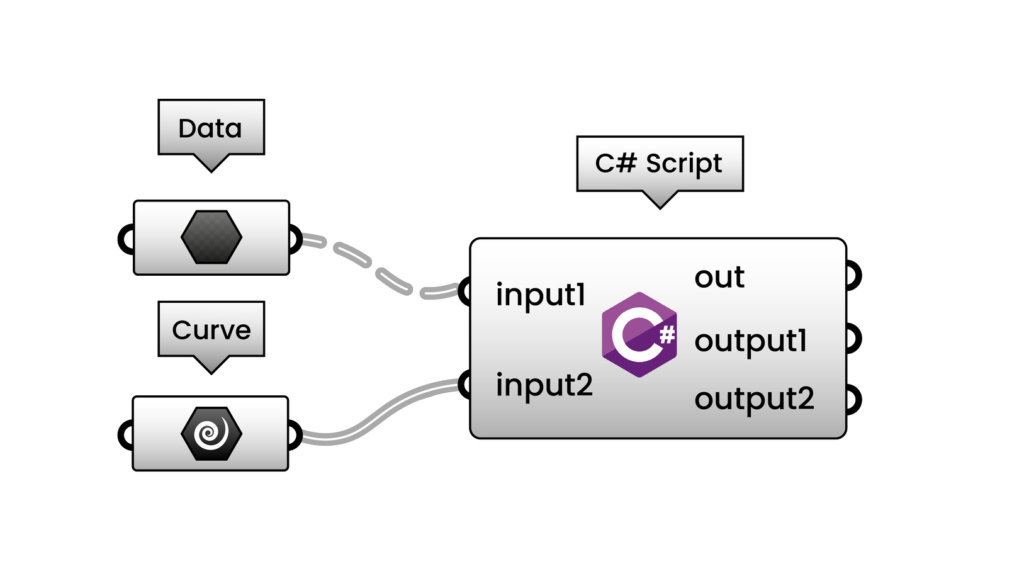
Of course we have made simillar exercises for Python in Grasshopper.

What is included?
// See what's included in the price

#1
Program
- Grasshopper Fundamentals -24h of video materials
- Python in AEC Fundamentals – 22h of video materials
- C# in AEC Fundamentals – 17h of video materials
- Variety of materials – expect videos, practical examples, engaging presentations, glossaries
- Homework – more than 500 unconventional, gamified, 100% practical exercises
- Lifetime access to the Learning Program and Community
Closed group access
After purchasing the Program, you will receive access to a closed group for ambitious Engineers - just like you.
It is a very valuable element of the Program. Why?
- Ask questions about programming in our no-stupid-questions zone
- Discuss the training program and related topics
- Exchange valuable online finds with group members
- Motivate yourself and others – learning is easier in a group
- Build your network – in a closed group it will be easier to get in contact with other enthusiasts of programming
- Receive support and guidance with homework
- And hey, we will be there too!
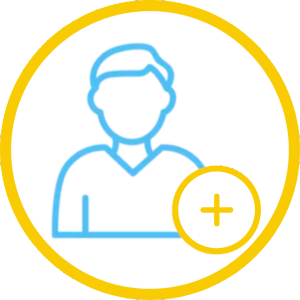
#2

#3
Bonuses
- Free program updates – if we add any new materials to the Programming in AEC Fundamentals program, you will get all the updates for free.
- Building Engineering Web Apps – With Python and Viktor, you can confidently create and share your engineering web apps with colleagues and clients.
- AI in AEC with Chat GPT – Bonus lessons about using Chat GPT for debugging and as a code generator. Explore the potential of AI for the AEC industry.
- Tekla, Revit, Speckle, Karamba API Modules – A fantastic primer to open the powerful features of AEC software using Open API.
- Rhino 8 new Script Editor – Discover what’s different and the exciting new features in the latest release of Rhino 8’s script editor.
- Documentation and Reporting with Python: Learn how to craft your own documentation and generate reports using Jupyter.
Training Program
Programming in AEC Fundamentals is a comprehensive starting point for those considering going beyond ”standard engineer work”. It teaches you the solid basics that are often overlooked in other materials and introduces you to the broader context: a variety of tools and the work methodologies associated with newest technologies.
Agenda Grasshopper Fundamentals
// See what you will learn in Grasshopper Fundamentals Training
In this introductory module, you’ll learn how the course is structured, who will teach you and how to get the most out of this comprehensive program.
00.00. Hello [07:16]
00.01. About the course [10:46]
00.02. About Author [04:43]
00.03. How to work with materials [16:00]
00.04. Discord Group [08:46]
00.05. First Exercise [02:33]
This module will give you a better understanding of Programming. You will learn the Computational thinking concept. Be familiar with the parametric design approach and how the entire AEC industry can benefit from it.
01.00. Intro [01:29]
01.01. Why should engineers
learn programming? [17:29]
01.02. Computational thinking [15:50]
01.03. Computer Programming [16:57]
01.04. Parametric Design [12:45]
01.05. Why Parametric Design? [15:15]
01.06. What is Rhino and Grasshopper? [16:01]
01.07. Grasshopper in Action [36:47]
We will dive into the basics of Rhino and 3D modelling. You will learn all essential Rhino commands and functions. You will gain all the necessary skills to work in Rhino together with Grasshopper.
02.00. Installation process [20:03]
02.01. Rhino Interface 1/2 [30:25]
02.02. Rhino Interface 2/2 [18:15]
02.03. Modelling in Rhino 1/2 [32:06]
02.04. Modelling in Rhino 2/2 [28:43]
Let’s get familiar with the Grasshopper interface. In this module, you will learn everything about canvas, Radial Menu, tollbars and how to work simultaneously in Rhino and Grasshopper.
03.00. Intro [02:13]
03.01. Grasshopper interface 1/3 [20:52]
03.02. Grasshopper interface 2/3 [14:24]
03.03. Grasshopper interface 3/3 [09:15]
03.04. Rhino with Grasshopper 1/2 [23:26]
03.05. Rhino with Grasshopper 2/2 [19:53]
03.06. Intro Grasshopper -Homework [03:02]
It is time to be familiar with script elements. You will learn all available parameters in Grasshopper, how to use wire functions, and understand the logic behind Grasshopper components.
04.00. Intro [04:15]
04.01. Grasshopper Parameters 1-2 [23:21]
04.02. Grasshopper Parameters 2-2 [28:43]
04.03. Wiring [11:01]
04.04. Grasshopper Components [13:22]
In this module, you will understand data as a list. Further, we will explore all essential components created for manipulating data in the form of a list.
05.00. Data [05:56]
05.01. List Creation [21:06]
05.02. List Management [19:26]
05.03. Working with lists [10:27]
05.04. Logic [18:02]
05.05. Mathematics [23:28]
All lessons in this module will be dedicated to Grasshopper elements such as points, vectors and planes.
06.00. Intro [01:46]
06.01. Points [27:18]
06.02. Vector [32:00]
06.03. Planes [28:24]
Now, it is time to start playing with geometry. This module covers all practical transformations such as move, scale, rotate, orient and project on.
07.00. Intro [01:38]
07.01. Basic transformations [33:02]
07.02. Advanced transformations [36:39]
07.03. Homework [05:40]
Finally, you are ready for advanced data management in Grasshopper. In this extensive module, we will go through the concept of data tree structures. How to create and manipulate data tree structures.
08.00. Data tree [01:44]
08.01. Data tree structure [26:09]
08.02. Data tree generation [25:55]
08.03. Data tree matching [18:37]
08.04. Data tree operations [35:44]
08.05. Homework [01:47]
This module covers all theories about parametric curves. You will learn all the useful components and start creating a geometry that consists of curves.
09.00. Intro [19:13]
09.01. Lines and polylines [20:48]
09.02. Modify polylines [43:04]
09.03. Curves division [19:12]
09.04. Curve operations [34:49]
09.05. Homework [06:06]
All lessons in this module will be focused on surfaces. First, we will dive into the theory and we will make numerous practical examples with the use of surface components.
10.00. Intro [11:37]
10.01. Primitives [10:14]
10.02. Free form [27:37]
10.03. Analysis [21:34]
10.04. Util [18:56]
10.05. Homework [06:08]
In one of the closing modules, we will go through diverse additional topics such as:
Text management, data visualisation, BIM in Grasshopper
11.00. Intro [01:02]
11.01. Text management [30:23]
11.02. Display [36:28]
11.03. Intersect [16:19]
11.04. Diverse [20:18]
Here you will get your certificate of completion of the course.
This module is dedicated to extra learning materials and practical advice about using Grasshopper. I’ll give suggestions about the next steps you can take on your journey into applying parametric design to your work.
13.01. Good habits while working with Grasshopper [39:59]
13.02. How to create clean Grasshopper scripts [01:11:08]
13.03. IFC Export from Rhino – VisualARQ [56:40]
13.04. Revit to FEM software workflow [26:58]
13.05. Extra exercises
13.06. Terrain in Grasshopper – Lands Design [59:05]
Agenda C#
// See what you will learn in C# training
In this introductory module, you’ll learn how the course is structured, who will teach you and how to get the most out of this extensive program.
00.00. Hello! [03:38]
00.01. About the course
00.02. About an author [06:02]
00.03. How to work with materials [06:42]
00.04. Discord Group [05:54]
00.05. First Exercise [03:11]
Learn about basic parts of C#, how they send and receive data, and how to use different types of simple data like numbers and words. You’ll also discover how to make points and lines, useful for construction tasks. The course ends with a lesson on creating your own simple C# component and an intro to practice exercises.
01.01. Introduction to the course, first component [07:43]
01.02. Component outputs [10:28]
01.03. Variables int string double [10:07]
01.04. Component inputs [11:43]
01.05. Basic definitions [12:59]
01.06. How to make point and lines [08:12]
01.07. Creating basic component in C# [14:42]
01.08. Introduction Lecture – Exercises
Learn to create and manipulate lists and arrays in C#. Use 'for loops’ and 'if statements’ to work with lists. Get hands-on experience by making a component for a truss structure.
02.01. Creating lists and arrays [14:37]
02.02. Creating list with for loop [14:16]
02.03. Creating if statement with list [17:03]
02.04. Operating on the lists [15:59]
02.05. Creating a component with a truss [23:07]
02.06. Data types and lists – Exercises
Learn how to work with text in C# through strings. Discover how to find text within strings and how to split strings into parts. Explore methods that return results and those that don’t. Create a component to sort labels, a useful skill for managing data.
03.01. String contain string [11:56]
03.02. Operations on string splitting [12:01]
03.03. Methods with and without results [11:18]
03.04. Component for sorting labels [18:05]
03.05. Text objects and methods – Exercises
Learn to create, read, and modify data trees, structures that organize your data. Explore how to use random numbers within data trees. Build a component that calculates capacity, useful for resource management.
04.01. Creating data tree [09:15]
04.02. Reading data tree [10:07]
04.03. Modifying data tree, random number [11:04]
04.04. Component which calculate the capacity [17:33]
04.05. Numeric objects and data trees – Exercises
Learn to work with curve objects in C#. Start by creating a list of points on a line, then move on to making curves. Discover how to create a grid of curves and a grid of polylines, useful skills for design and modeling.
05.01. Creating list of points on the line [13:33]
05.02. Creating curves [09:54]
05.03. Creating grid of curves [28:08]
05.04. Creating grid of polylines [18:16]
05.05. Curve objects – Exercises
Learn to create and manipulate surface objects. Make surfaces from points and through extrusion, and explore lofting techniques. Modify surfaces using control points and build a component to construct a gridshell from a surface.
06.01. Surface from points and extrusion [10:50]
06.02. Surface loft [08:46]
06.03. Surface loft and from network of points [18:20]
06.04. Modifying surface by control points [29:03]
06.05. Component to build gridshell from surface [18:45]
06.06. Surface objects – Exercises
Get hands-on experience with Boundary Representation (BREP) objects. Start by creating basic shapes like spheres and cubes. Learn to create BREPs along an axis and how to close them.
07.01. Creating sphere and cube [10:29]
07.02. Creating brep in the axis, closing brep [11:20]
07.03. Creating surface for gridshell [15:15]
07.04. Creating columns and trimming and intersection [21:00]
07.05. Creating brep objects from axis [24:51]
07.06. Brep objects – Exercises
This module provides extra content to boost your C# skills. Practice various methods, learn to export data to Excel, and build an analytical model in two parts. Get an introduction to using C# in Visual Studio and Tekla, expanding the scope of your projects.
08.01. Methods, Exercises
08.02. Export Excel [13:41]
08.03. Analytical model – Part 1 [35:19]
08.04. Analytical model – Part 2 [34:35]
08.05. Visual Studio [20:44]
08.06. C# in Chat GPT-4 [52:59]
08.07. C# in Tekla [01:05:45]
08.08. C# in Rhino 8
08.09. C# in Speckle
08.10. C# in Karamba
Dive into the theory behind C#. Understand the concepts of converting types, working with instances, and creating classes. This module gives you the foundational theory to understand the practical exercises better.
Theoretical issues classes [08:06]
Theoretical issues instances [04:25]
Theoretical issues converting [04:59]
Agenda Python
// See what you will learn in Python training
In this introductory module, you’ll learn how the course is structured, who will teach you and how to get the most out of this extensive program.
00.00. Hello [04:18]
00.01. About the course [10:11]
00.02. About an Author [05:16]
00.03. How to work with materials [05:33]
00.04. Discord Group [05:53]
00.05. First Exercise [03:11]
Uncover the essential components that make up Python. Learn how to display and capture data effectively. Grasp the concept of using variables to store information.
01.01. Introduction to the course [14:54]
01.02. The Python component [12:47]
01.03. Output data [07:09]
01.04. Input data [15:12]
01.05. Variables [14:49]
Start by exploring strings and their operations, then dive into the numeric types: integers and floats. Familiarize yourself with Booleans for true-false logic, and delve into Python’s versatile collections – lists, dictionaries, tuples, and sets.
02.01. Strings and string operations [33:07]
02.02. Integers and Floats [19:01]
02.03. Booleans [18:52]
02.04. Lists [19:41]
02.05. Dictionaries [15:38]
02.06. Tuples and sets [17:34]
Begin your exploration with the basics of points, and then smoothly transition into the geometric intricacies of lines, curves, and surfaces. As you progress, delve deeper into the advanced structures of Breps and meshes.
03.01. Rhino API and modules [16:10]
03.02. Points [16:57]
03.03. Lines and Curves [32:09]
03.04. Surfaces [23:56]
03.05. Breps [31:28]
03.06. Mesh [23:25]
03.07.01. Case study – Truss Part 1 [16:39]
03.07.02. Case study – Truss Part 2 [14:19]
03.07.03. Case study – Truss Part 3 [12:07]
Kick off with conditional statements, mastering the use of „if”, „else”, and „elif”. Transition into iterative processes with „for” and „while” loops, learning their nuances and applications.
04.01. If statement [20:16]
04.02. The else statement [22:44]
04.03. The elif statement [10:30]
04.04. For loops [28:54]
04.05. While loops [17:33]
04.06. Combining loops and conditionals [20:12]
We’ll start with how to make your own functions and how to get results back from them. You’ll also explore some helpful built-in functions and dive a bit deeper into the world of functions.
05.01. Creating functions [19:46]
05.02. Returning functions [23:38]
05.03. Useful python functions [27:24]
05.04. Some more about functions [22:45]
05.05. Lambda functions [24:42]
05.06. Typical errors and how to handle
You’ll learn how to open files and read from them, pulling out the information you need. Then, you’ll see how to write or add your own data to these files. You’ll also understand how to make sense of a file’s structure and how to save your findings in a results file.
06.01. Open text files in Python [17:59]
06.02. Read and extract data [15:41]
06.03. Write data [21:49]
06.04. Structure from file
06.05. Write results file [14:48]
You’ll start with an introduction to Treehelpers and then move on to using Grasshopper components within scripts. You’ll get a good grasp of rhinoscriptsyntax and create a script specifically for adding layers in Rhino.
07.01. Treehelpers [21:14]
07.02. Gh components in scripts [19:16]
07.03. Rhinoscriptsyntax [18:01]
07.04. Create script for adding layers [17:35]
07.05. Rhinoscriptsyntax in Grasshopper [08:41]
07.06. Working on Rhino objects from Grasshopper. Scriptcontext [24:15]
You’ll explore coding in Visual Studio Code, dive into Rhino 8’s features, and build engineering web apps with ViktorAI. Additionally, you’ll integrate Python with the Revit API and get hands-on with Jupyter Notebook.
08.01. Rhino 8 [1:29:11]
08.02. Visual Studio Code [1:01:46]
08.03. ViktorAI [1:22:22]
08.04. Revit API with Python [2:33:08]
08.05. Jupyter Notebook [1:40:07]
08.06. Python Speckle
08.07. Python 3 in Rhino 8
08.08. GitHub Introduction
08.09. Python for Structural Design
What programming language should I learn?
Fill out this quick survey and you will get a recommendation
on which language will be the best for you.
How much does this Program cost?
// See what you pay for
- Lifetime access to: Grasshopper Fundamentals + Python in AEC + C# in AEC - from scratch which helps you reach intermediate programming level, at your own pace, at your own schedule
- Step-by-step approach: easily digestible bites of theory, followed by presentation of practical examples and individual practical assignments
- Lifetime access to a closed Programming in AEC community – a space for questions, discussions, and mutual support on your learning path
- Three Live Q&A sessions with Trainers where you can get real-time answers to your questions
- +500 engineering examples of the application of Grasshopper, Python and C# with well-prepared practical assignments and homework
- 100% Satisfaction Guarantee – 30 days refund, no questions asked

It all - and even more - costs:
2997 EUR
891 EUR
It is just ~5EUR FOR ONE DAY OF STUDYING!
You're probably spending more on coffee or beer.
- IMPORTANT! IT WILL BE ALWAYS MORE EXPENSIVE
Your turn.
Do you want to become an Engineer 4.0?
This offer is valid until 21:00 CET on 28th November 2024
Can You JOIN ONLY ONE TRAINING?
YES YOU CAN!
We understand that undergoing both trainings might be overwhelming due to the volume of knowledge. That's why we offer the OPTION to join programs separately.
However, keep in mind that the best deal is available when you join all trainings at once. You'll receive lifetime access, allowing you to complete trainings at your own pace, even if it's a year or two down the road. Secure best price now!
By buying three trainings in package you can save more than 72 EUR.
Remember that each future edition of the trainings will be more expensive.
Today's offer is the lowest possible.
You risk nothing!
We are confident that Programming in AEC Fundamentals will meet your expectations. So confident that if we let you down, we’ll give you 100% of your money back!
You have 30 days to resign from the course. One e-mail and the cash transfer goes back to your account.
No hard feelings, no questions asked!
any questions?
We have nothing to hide!
If you need more information, please send us an email to: contact@programmingInAEC.com
NOTE!
Before sending an email, please check the FAQ section below. You may get your question answered right away!
And now ... the decision!
Your turn.
Will you make the next step to becoming an Engineer 4.0 with us?
FAQ
Your account will be created on the educational platform immediately after payment. Details on how to access the training will be provided by email. If you bought more than one training access, we will contact you directly.
You will receive the first intro module immediately after purchase. The following modules will appear every Thursday at 21:00 CET on the online platform. The aim for students is to work through the training materials systematically and be able to support each other with practice problems and homework.
These are 3 separate online courses. In total they consist of 63 hours of recorded video lessons ( You can find demo lessons here Computational thinking, Creating basic component in C# , Rhino API and modules ).
All of this will be available on the online platform. All you have to do is log in to the platform after purchase and this vault full of information will be available to you.
After each C# or Python lesson, there are practical assignments that will help you better understand and implement what you’ve learned. Practice is key to successful learning, so we have prepared more than 200 practical exercises for you.
You can pay for the course via Stripe. And yes, everyone will receive proof of purchase in the form of an invoice. Please fill in all information that you want to have on your invoice during checkout. If you want to pay with a bank transfer, please on the checkout page fill out all details and choose Direct Bank Transfer option. If you will have any problems just write to us contact@programmingInAEC.com.
Yes, of course. Our primary goal is for you to learn Programming in AEC and implement it in your day-to-day work. If you decide that you are not getting what you wanted out of this course or would like a refund for any reason during the first 30 days after purchase, I will fully refund you.
You will receive the full amount you paid refunded into your account, no questions asked. Ok, maybe one question asked, what would make my course better? But you don’t have to answer it. The refund is still unconditional.
Yes! We’re using a Discord group for our online community. Access to the group will be restricted to students, and comments will be monitored. There will be no trolls and no trolling.
We will be active members of the group and will help students and answer questions along with the community. We will also organize two Live Q&A sessions during the training course through this group.
Programming in AEC training is an obvious advantage for you as an engineer but also for your company. You can always try to get reimbursement for your work!
If you work as an engineer, consultant, or architect and you aren’t sure how to get your employer to fund this training, I created a One Pager for your manager that will help persuade them to purchase the training for you.
You can sign up for just one training if you want to. We know that taking 3 trainings at once might be too much because there’s a lot to learn. So, you can choose to join either the Grasshopper if you are a tottally beginer or Python in AEC or the C# in AEC training if you more advanced. You’ll find links for each one above.
But remember, it’s a better deal if you sign up for a package of 3 trainings. You’ll get access that never expires, so you can finish the training in your own time, even if it takes a couple of years.
If you’re new to Grasshopper, we’ve got a special deal. You can join Grasshopper Fundamentals Training at a discount. This is perfect for beginners and covers key topics to get started in the world of computational design.
After you finish it you can explore Python and C# trainings within the Grasshopper environment. We’ve seen that students pick up programming quicker when they use these languages in a visual setting. We’ll start with the basics and then move on to more complex tools like Visual Studio Code and Jupyter.
You don’t need to be a Grasshopper expert, but basic knowledge can help. We’ll teach C# and Python from the beginning and won’t focus too much on the visual programming aspect. Don’t worry, there’s a 30-day money-back guarantee. If the course is too hard, you can get a full refund.
Absolutely!
This training was specially created for learners without any coding experience. The training begins with theory and basic concepts. However, with every following module, we will do more and more advanced work. Many advanced users went through this training and still learned A LOT.
In Programming in AEC Fundamentals Training, we go through practical application of text-based programming in the AEC industry. We are 100% sure that even if you have used C# or Python, you will find something new in this training.
Check out our Bonus materials for some cool extra learning:
Learn how to build functional, attractive engineering web apps using Python, integrate Python and C# with Revit and Tekla for doing more with this software, and discover how ChatGPT can assist in debugging and refining your code.
Remember that if it turns out that this training is not advanced enough for you, you can always request a refund within the first 30 days and get 100% of your money back.
This information is especially relevant for companies. YES, you can buy multiple licenses by placing one group order. You can do this by just increasing the number of items in your cart. we will contact you after the payment has been confirmed.
Don’t forget! For every 7 purchases, you will automatically get one for free. If you buy 14, you will get two and so on. After paying for the order, we will send you all information on how users can access the learning platform.
Nope! This is a one-time purchase. When you buy the Programming in AEC Fundamentals, you’ll always have access to it.
Not only that, but you’ll get all updates and additions for free. We plan on constantly updating and improving the training over the next couple of years!
In general it is a 24-week program (8 weeks Grasshopper Fundamentals, 8 weeks Python in AEC and 8 weeks C# in AEC) and on average, you will need about 6 hours per week to watch all the videos, read through the course materials and go over all the practical exercises. Statistics from users that have done this training show that you need about 140 hours to complete Programming in AEC Fundamentals.
Remember, don’t worry if you don’t have time to start the course right now. You have lifetime access, so you can start and go through the lessons whenever you have time.
In this training, we are using Grasshopper scripts editors in Rhino 7/ Rhino 8. Grasshopper comes together with the installation of Rhino. Rhino Evaluation can be downloaded from the official Rhino website for free. After registration, you will receive a ready-to-use 90-day full license. This license is enough to get you through all the course modules with extra weeks after you have finished the training.
If you allready used eveluation license please write an email directly to kris@learngrasshopper.com and we will check what can we do.
No, you don’t have to, but we strongly recommend starting together with others. If you start along with the other students, you are more likely to finish the training. We are going to organize two live Q&A sessions with trainers so that they can assist you and help with any points you may be having difficulty with.
Yep! Anyone who completes the training will get a certificate in a PDF format with their name on it, showing that they’ve completed the Grasshopper Fundamentals, C# in AEC Fundamentals and Python in AEC Fundamentals. This can be useful to claim reimbursement from your employer, to share on social media, or to just feel great about your accomplishment!
All Clear?
Great, now we can start learning together!
After joining the Programming in AEC Fundamentals program, congratulate yourself!
In just a few short weeks, you’ll gain necessary skills and you will be on the right path to becoming an Engineer of the future.
And if you are still here but have not hit this button yet…



